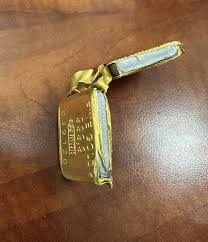The Troy Ounce of Gold: A Comprehensive Guide

precious metals, measurements are crucial to maintaining consistency and fairness in trading. One such essential unit of measure is the troy ounce, a metric that often confuses those new to precious metals markets. This article will provide a deep dive into what a troy ounce of gold is, its origins, why it’s used, and its implications in today’s market.
1. What is a Troy Ounce?
- Definition: A troy ounce is a unit of weight specifically used for precious metals like gold, silver, platinum, and palladium. It differs slightly from the more commonly used “avoirdupois” ounce.
- Conversion specifics: A troy ounce equals approximately 31.1035 grams, while a standard (avoirdupois) ounce equals around 28.3495 grams.
- Use in precious metals: Unlike many other commodities measured by the avoirdupois ounce, precious metals are measured in troy ounces to ensure consistency across global markets.
2. Historical Background of the Troy Ounce
- Origins in Ancient Civilizations: The concept of the troy ounce dates back to ancient civilizations, where specific measurements were created to facilitate fair trade and currency standards.
- Medieval Europe and Troyes, France: The term “troy” is thought to come from the French city of Troyes, an important trading hub in medieval Europe where merchants used a standardized weight for precious metals.
- Evolution Over Time: As trade spread, so did the use of the troy ounce, eventually becoming the standard measure for precious metals in Britain and later in the United States.
3. Troy Ounce vs. Avoirdupois Ounce
- Key Differences: The troy ounce (31.1035 grams) is heavier than the avoirdupois ounce (28.3495 grams). This difference may seem minor but is significant in precious metals trading, where fractions of an ounce can translate to considerable differences in value.
- Implications in Gold Pricing: Since gold prices are quoted per troy ounce, it’s essential to understand this unit’s value. Even a small miscalculation between troy and avoirdupois can lead to significant financial discrepancies.
4. Why the Troy Ounce Matters in Gold Trading
- Global Standardization: The troy ounce has become a global standard for gold, making it the unit of choice for pricing and trading. This standardization allows investors and traders worldwide to participate in the gold market on equal terms.
- Impact on Pricing and Investments: Investors in gold need to know the troy ounce measurement to understand spot prices and avoid losses due to misinterpretation of weight measurements.
5. How the Troy Ounce is Used in Today’s Gold Market
- Pricing Gold by the Troy Ounce: Gold prices are typically quoted in troy ounces on financial markets. For example, if the price of gold is $1,800 per troy ounce, this price refers to 31.1035 grams of gold.
- Gold Bars and Coins: Gold bullion products are sold in various sizes, often measured in troy ounces or fractions thereof (e.g., 1/10th troy ounce coins). This standardization ensures clarity for buyers and sellers.
6. Conversions and Calculations
- Converting to Other Measurements: Understanding conversions can help in buying and selling gold in different weight measurements, such as grams, kilograms, or avoirdupois ounces.
- Practical Calculation Example: How to calculate the cost of gold if a buyer wants to purchase 10 grams instead of a full troy ounce.
7. The Importance of the Troy Ounce for Investors and Collectors
- Stability and Reliability: For investors, the troy ounce provides a stable measurement that hasn’t changed over centuries, creating trust in the market.
- Application in Portfolio Diversification: Investors looking to diversify with gold need to understand the troy ounce to make informed decisions regarding allocation and risk management.
8. Why Knowledge of the Troy Ounce is Crucial for New Investors
- Avoiding Misunderstandings in Pricing: For first-time buyers, knowing the difference between ounces is essential to prevent overpaying or underestimating the value of their investment.
- Learning from Market Trends: By tracking price per troy ounce over time, investors can better anticipate market trends and make data-driven decisions.
9. How the Troy Ounce Influences the Spot Price of Gold
- Spot Price Definition: The spot price of gold is the current price in the market for an immediate transaction. It’s typically quoted in U.S. dollars per troy ounce.
- Global Demand and Supply: The troy ounce measurement allows for accurate comparisons in demand and supply across different countries, impacting the spot price.
10. Real-World Application of the Troy Ounce in Gold Trading Platforms
- Trading and Investing Platforms: Most online platforms for trading gold (like ETFs, futures contracts) use the troy ounce as the standard unit of measure, helping traders understand value at a glance.
- How Platforms Reflect Price Changes: Understanding price per troy ounce helps traders track profit or loss.
11. Misconceptions and Common Mistakes about the Troy Ounce
- Mixing Up Ounces: Some new investors mistakenly believe the gold ounce price applies to the standard ounce, leading to potential misunderstandings.
- Miscalculating Weight: Failing to consider that gold bars and coins are weighed in troy ounces can lead to overestimating or underestimating their value.
12. Is the Troy Ounce Here to Stay?
- Historical Resilience: Given its long history and global acceptance, it’s likely the troy ounce will remain the standard measure for gold and other precious metals.
- Potential for Metric System Transition: Some industry experts speculate about a possible shift toward the metric system for precious metals, but many traders and investors feel the troy ounce provides a traditional, reliable standard.
Conclusion
The troy ounce of gold is more than just a unit of weight; it’s a foundational aspect of the global gold market. Its consistency over centuries has allowed traders, investors, and collectors to evaluate, buy, and sell gold with confidence. Whether you’re an investor or simply someone interested in precious metals, understanding the troy ounce and its unique characteristics is essential to navigating the market effectively.





